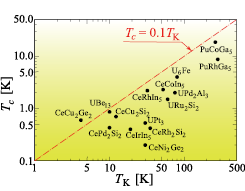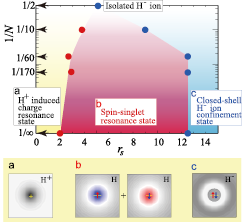Emergence of a Kondo Singlet State with TK ≈ 2000K in the Proton-Embedded Electron Gas: Route to High-Tc Superconductivity
Takada Group
Physics in heavy fermion superconductors has been understood by the concept of quantum criticality in a Kondo lattice and the spin-fluctuation mechanism is believed to be responsible for superconductivity, as inferred from the strong correlation between Tc and TK. More specifically, Tc is of the order of 0.1TK, as shown in Fig. 1, from which we can conceive an idea that high-Tc superconductivity will be obtained if we can discover a Kondo system with very high TK. In fact, the recently-discovered plutonium compounds such as PuCoGa5 with Tc=18.5K and TK≈260K may be regarded as a successful realization of this idea. Thus we should make further pursuit of this idea by searching for a new class of Kondo systems with TK higher than 1000K. Theoretically, this search can be done by the first-principles quantitative determination of TK for the composite system of an impurity atom embedded in a metal.

Fig. 1. Superconducting transition temperature Tc versus Kondo temperature TK (a characteristic energy scale for spin fluctuations) in heavy fermion superconductors.

Fig. 2. Phase diagram for sharp sequential transitions among (a) charge resonance, (b) spin-singlet resonance, and (c) closed-shell H- ion confinement states in the proton-embedded electron gas with N the total number of electrons and rs the electron density parameter to specify the electron gas.
As first suggested by Debye and Hückel, an atomic nucleus charge +Ze in a metal is screened by accumulation of metallic electrons which is regarded as a charge resonance and well described by the linear response theory. This concept of metallic screening is prevailing for a century, but because Z is not infinitesimally small, we need to consider nonlinear effects in the screening, including the contribution from spin fluctuations. The spin contribution will be enhanced, if Z is an odd integer, such as Z=1 (case of a proton), in which a spin-polarized bound state might appear at the impurity atom.
With the above basic scientific issues in mind, we have concerned with the problem of hydrogen impurity in metals which attracts long attention from a technological point of view, such as hydrogen storage in solids, sensor applications, and catalysis. Its electronic state has been investigated in terms of a proton immersed into the electron gas since 1970s, but no serious attention has been paid so far to the spin resonance effect.
We have studied this system with changing the electron density in a wide range by employing the diffusion Monte Carlo simulations with the total electron number N up to 170 to accurately obtain the ground-state electronic distribution n(r) and found a sharp transition at rs≈2 from short-range H+ screening charge resonance to long-range Kondo singlet resonance, the emergence of which is confirmed by the presence of an oscillation-period-shortened Friedel oscillation characteristic to the Kondo singlet state with TK well beyond 1000K for rs in the range 3-8. Another transition to the closed-shell H- confinement state occurs at rs≈12.5 (see Fig. 2).
This study not only reveals interesting competition between charge and spin resonances, enriching the century-old paradigm of metallic screening to a point charge, but also discovers a long-sought high-TK system, opening a new and unexpected route to room-temperature superconductivity in a Kondo lattice made of protons. The metal hydrides, usually used for secondary batteries, are promising candidates, if the metallic electron density is suitably arranged and the lattice constant is properly tuned to exhibit quantum criticality in the Kondo lattice.
References
- [1] Y. Takada, R. Maezono, and K. Yoshizawa, Phys. Rev. B 92, 155140 (2015).
